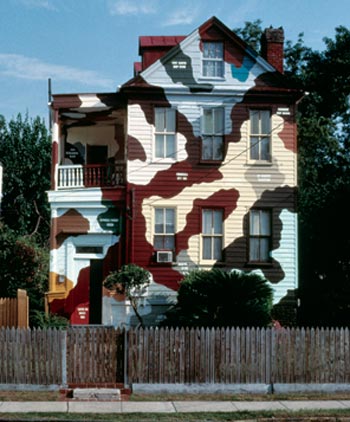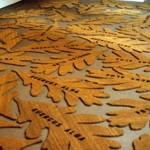The irony of much public art, especially that which came in the last third of the 20th century, is that it is hardly public at all. It does not engage the intended audience; it is too abstruse and inaccessible for the actual public who is disinterested and ‘un-educated.’ The nomenclature of Public Art came to even have a pejorative connotation spawning other terms such as Plop Art. The late Kate Ericson and Mel Zeigler, the husband and wife duo whose work fills the halls of MIT’s List Visual Art Center until April 9, 2006 in the show America Starts Here worked against these norms. They created conceptual and minimalist works that involved political and economic issues, history and national iconography to cross the barriers around most public art works and engage more people’s minds thus making the work more “public.” They realized their work with both intellectual accessibility and its placement within a public context, formerly the sole requirement for public art, two ideas which until Ericson and Zeigler’s presence in the art world, rarely saw each other.
Ericson and Ziegler came of age and studied art in the same America where people like Robert Morris, Sol Lewitt and Robert Smithson commanded rich caches of art importance. Smithson is a cited influence on Ericson and Ziegler and it’s apparent in their works and materials throughout their 10-year collaboration as well as in works they created as individuals before becoming a joined entitey. Other influences were Alice Aycock, Gordon Matta-Clark and of course, Christo. Their interests in these artists served only as a stepping-stone for their work, however, as they found those artists’ limited engagement with the public unsatisfying. Ziegler stated that he and Ericson wished to “fit [them]selves into an existing urban pattern, to infiltrate something about to happen anyway and make art out of it.” (press release) They “found materials and places already existing that [they]could use and manipulate” while “searching for socially active spaces in which to work.” (from catalogue, pp. 29-30). Christo’s work also influenced them for what it is was not. Zeigler continued, “it is mostly about being big, beautiful and visually expansive. But everything else that goes behind it, all the social aspects of convincing governments, convincing people, convincing land owners…is the most interesting part of it.” (p. 31) Many of their titles, indeed suggest a state of being such as The Smell and Taste of Things Remain (1992) or part of a process: From the Making of a House (1995).
That process often incorporated the audience as participants. Ericson and Zeigler were not only self-consciously engaging their audience, but involving them to such a degree that their works could not be completed without audience participation. In some cases the participants more or less became part of the piece such as in Signature Piece (1988) where they requested signatures from the people who manufactured the materials that made up the fixtures and general architecture of MoMA. They then took those signatures and applied them as labels to the materials in the setting of an Art Museum. In House Monument (1988), a break-out piece for them as it appeared on the cover of ArtForum, they inscribed quotations about what makes up a house or home onto enough lumber to build an entire single family home. They then placed an add in the Los Angeles Times advertising the lumber for sale, but at a discounted price as compensation for participation in an “art project.” Two of their more outspoken public collaborations dealt with social and economic stratification as perpetuated by urban planning and development. Camouflaged History (1991), is a quintessential work of theirs and the show’s poster work. A house just outside the city-designated historic district of Charleston, South Carolina was painted in a military specified camouflage pattern in all the “Authentic Colors” designated by the Charleston Board of Architectural Review for houses in the historic district. Each color has an assigned historical significance; “Fort Sumter Deep Stone” and “Huguenot Deep Brown” are just two colors effecting their entitlement on their privileged home. I admit I was informed by “Huguenot Deep Brown” in that I was unaware there was a Huguenot settlement and church still in operation in the area of Charleston. There is value in this, as it is a teaching tool in the same way that Ericson and Zeigler’s appropriation of so-called historic colors stands as, but the historical designation of one area causes another to be overlooked, an entire class to be overlooked. The people who make up that class, because they don’t live in the historical neighborhood, are camouflage. Though, if they are designated the rite those colors entail, they might blend in with the history of the United States.
Ericson and Zeigler carried this idea further with Eminent Domain (1993) where they worked with the residents of a low-income housing complex to change the names of the interior paints to reflect these residents’ social and economic history and market the paints nationally at True Value hardware stores. “Urban Renewal Lime” and “Authority White” are two examples of color renamings that Ericson, Zeigler and residents came to after long discussions about the residents’ experience there. The show’s press release states that, “Ericson and Ziegler worked with people from outside the academy in ways that incorporated voices too often unheard in the world of contemporary art,” but it seems that the people they worked with are actually too often unheard of in general. Eminent Domain is sometimes criticized for appearing in galleries as it is presented only as a paint chart, disassociating the experience of the work’s participants and highlighting only their plight. This is a common problem of a few pieces in the show and many in their body of work; they are leftover pieces of performances or remnants, missing their original context. Bill Arning, one of the show’s curators takes aim at the Ericson and Ziegler’s naysayers stating frankly, “To restrict a public project’s benefit to art world concerns—the delectation of conceptual arts enthusiasts, the stroking of artistic ego, or career advancement—would be indefensible. Ericson and Zeigler addressed these hard questions by creating works that left the situations they encountered better places.” (15) It is hard to say that Eminent Domain created a better place for its participants and inhabitants, but it gave them a new voice and enabled them to re-express their experience with a sense of irony and much needed humor. Often, as in the case of Signature Piece and House Monument, they compensated their participants financially.
Less successful works seemed to be responding only to the practice of creating art, as they avoided “mak[ing]and add[ing]objects to an already cluttered world.” (p 24) “The Smell and Taste of Things Remain (1992) works with the memories associated with certain objects, aiming inwards by combining related items in an attempt to symbolize what makes up the United States’ heartland. The piece is made up of a 19th century pie cupboard, holding glass jars, sandblasted on each the recipe for a pie from a different area of the United States. Inside each jar is a scent Ericson and Ziegler commissioned a perfumer to make based on his interpretation of old books and records held in the national archives. The perfume throws off the piece, however, the association with the perfume and the jars cabinet is less intuitive than other works and you can’t even smell the perfume because it is in sealed jars.
The body of work becomes tedious with the jars, many of which are included in America Starts Here. All of the jar pieces seem to contain three variables: what’s inside them, what’s sandblasted on them, and how they are presented to the viewer. I don’t know what the significance of the jars is and all of the pieces need wall text in order to explain their meaning—this deviates from their more successful community involvement pieces. If you use the same formula to explain the significance of a piece like Camouflage History, that you would for Smell and Taste of Things Remain, you may be left searching. There just isn’t the same coherence between the jar works’ elements. Even still, with their jar pieces they created a faux-genre of their own which functioned well as a medium for many works in dialogue with U.S. History, preserving their contents: paint, Potomac River water and baby food, and allowing them to be re-considered by an audience who would take them for granted.
Jane Farver, the LVAC’s director remarks that Ericson and Ziegler’s work had a “prescience” as it influenced public art as a practice and introduced conceptual art into the public sphere. Furthermore, Bill Arning diligently lists the 17 strategies of Ericson and Ziegler which have become commonplace for young artists. Natalie Loveless, a Big RED and SMFA alumnus, excels with this kind of work which has grown in popularity over the last decade since Ericson passed away making this a good time to present such a show. The show’s 216 page catalogue seems complete in that it includes every one of Ericson and Ziegler’s collaborative works along with personal essays from 10 curators who have worked with them. Bill Arning’s personable affect is apparent in his writing which is sprinkled with charming anecdotes about his initial interactions with Ericson and Ziegler 20 years ago and Ian Berry’s insightful interview provided me with answers to many of the questions I had about the show’s work.
It may be this show, which travels to Austin, TX, Kansas City, and Cincinnati, which cements Ericson and Zeigler’s place within the ‘Art Historical Context’ while celebrating their importance for their influence on conceptual work being produced by young artists today. Despite some of the difficulties of their work and the issues of documenting performance and ephemeral art, notwithstanding, America Starts Here follows the calibre of shows organized by the LVAC and will garner them with more of the distinction they are accustomed to.
 Read Micah J. Malone's
Read Micah J. Malone's
"Conversation With Mel Ziegler"
in this issue.
----
Links:
MIT List Visual Arts Center
"America Starts Here: Kate Ericson and Mel Ziegler" is on view February 9-April 9, 2006 at The List Visual Arts Center at MIT.
All images are courtesy of the artist and The List.






